

On 8th April we set off from Cotonou in Benin to Lagos, the capital of Nigeria. We had arranged to rejoin the overland tour in Kano in northern Nigeria. After considering our schedule carefully we decided that we would fly from Lagos up to Kano since the journey sounded boring and time consuming. On arrival at the domestic airport in Lagos we found that there was a flight to Kano leaving in twenty minutes. We frantically rushed around to change money on the black market and buy the tickets. A few minutes before the scheduled departure time Paula and I were running across the tarmac to get to the waiting jet before they pulled away the boarding stairs. Exhausted we rushed up the stairs, the crew closed the main door behind us and before we could find our seats the plane was taxiing to the runway - only in Africa!
 On 11th April Paula and I rejoined the overland trip.
The trip had ended up going via Senegal and many of the highlights of West Africa had been
skipped. We were both very glad that we had done West Africa independently, however, the
others on the trip now resented us. Back on the trip we visited the Yankari Game Reserve
and saw a good deal of animals including elephants, water buck, baboons, gazelle and some
impressive birdlife. After the game drive we visited the beautiful Wikki hot springs. The
crystal clear pools were idyllically set in lush tropical vegetation with baboons playing
in the trees overhead.
On 11th April Paula and I rejoined the overland trip.
The trip had ended up going via Senegal and many of the highlights of West Africa had been
skipped. We were both very glad that we had done West Africa independently, however, the
others on the trip now resented us. Back on the trip we visited the Yankari Game Reserve
and saw a good deal of animals including elephants, water buck, baboons, gazelle and some
impressive birdlife. After the game drive we visited the beautiful Wikki hot springs. The
crystal clear pools were idyllically set in lush tropical vegetation with baboons playing
in the trees overhead.
 We crossed into Cameroon on 14th April and traveled
to Rumisiki, which was in a spectacular mountainous region. The mountains were pinnacle
shaped and set off by a brewing thunder storm. From Rumisiki we did a day trip to an
interesting market at a town called Tourou. The market is famous for the local population
whose women wear decorated gourds on their heads to signify their marital status and
number of children. The women of the tour found it all very sexist, but it was
interesting.
We crossed into Cameroon on 14th April and traveled
to Rumisiki, which was in a spectacular mountainous region. The mountains were pinnacle
shaped and set off by a brewing thunder storm. From Rumisiki we did a day trip to an
interesting market at a town called Tourou. The market is famous for the local population
whose women wear decorated gourds on their heads to signify their marital status and
number of children. The women of the tour found it all very sexist, but it was
interesting.
We traveled down through Cameroon towards the border with the Central African republic (CAR) and visited the Chutes de Telo and the Benoue National Park. We entered CAR through the border town of Garoua Boulai and headed quickly down to the capital, Bangui. Bangui was not really that spectacular, but we took advantage of the good patisseries and spent the night in a luxury hotel to give us a break from the group and camping.
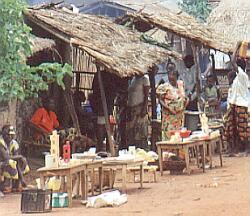 On 25th April we loaded the truck onto a small ferry
to take us across the Ubangui River to Zongo in Zaire. On the Zairian side of the river
there was no jetty so we beach landed and drove the truck onto the sand. Within a few feet
the truck sank into the sand and we were stuck - we had only been in Zaire a few minutes
and we were already bogged! After an exhausting hour an half of sand matting we managed to
get the truck up on to the main road, which was a dirt track! Next we had to negotiate for
over an hour with corrupt officials who wanted a bribe to allow us to continue. The badly
pot holed and narrow track took us into some pretty dense forest as we slowly made our way
towards the Congo river. Just as the sun was beginning to set we were attacked by a swarm
of nasty biting flies which had invaded the truck - the next few weeks crossing Zaire were
going to be tough!
On 25th April we loaded the truck onto a small ferry
to take us across the Ubangui River to Zongo in Zaire. On the Zairian side of the river
there was no jetty so we beach landed and drove the truck onto the sand. Within a few feet
the truck sank into the sand and we were stuck - we had only been in Zaire a few minutes
and we were already bogged! After an exhausting hour an half of sand matting we managed to
get the truck up on to the main road, which was a dirt track! Next we had to negotiate for
over an hour with corrupt officials who wanted a bribe to allow us to continue. The badly
pot holed and narrow track took us into some pretty dense forest as we slowly made our way
towards the Congo river. Just as the sun was beginning to set we were attacked by a swarm
of nasty biting flies which had invaded the truck - the next few weeks crossing Zaire were
going to be tough!
 We spend another three days driving through the
forest down to the port of Lisala on the mighty Congo river. On the way we passed many
little villages with friendly people and very excited children. When we reached Lisala
there was a large river steamer moored, so Paula and I went down to the dock to check it
out. The river steamer had several barges lashed to it's side forming a kind a floating
village. The whole thing was packed with passengers, sellers and animals, and seemed
filthy. Oblivious to all of the commotion on the steamer local fisherman were casting
their nets from their pirogue.
We spend another three days driving through the
forest down to the port of Lisala on the mighty Congo river. On the way we passed many
little villages with friendly people and very excited children. When we reached Lisala
there was a large river steamer moored, so Paula and I went down to the dock to check it
out. The river steamer had several barges lashed to it's side forming a kind a floating
village. The whole thing was packed with passengers, sellers and animals, and seemed
filthy. Oblivious to all of the commotion on the steamer local fisherman were casting
their nets from their pirogue.
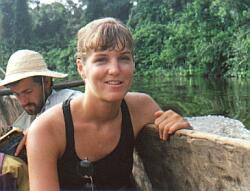 From Lisala we traveled by road down to the next port
of Bumba. In Bumba we got together with ten of the others from the trip and arranged to
travel by pirogue down to Kisangani, some 400km upstream. The journey was to take around
three days so we packed day sacs and some provisions before boarding the pirogue and
setting off in the early afternoon. Our pirogue was a fairly large dugout with an outboard
to push us up stream. There were no seats or cover from the elements, so it was a tough
three days traveling day and night up the mighty Congo. There were very few landmarks on
the journey between Bumba and Kisangani so we simply sat back and watch the forest roll
by. The nights were pretty uncomfortable as we traveled in the pitch black, trying to
sleep on the hard wooden bottom of the pirogue with the occasional shower of rain. A few
times we put into the river bank to pick up some fresh fruit etc. and were swamped by
young kids swimming around the pirogue in a frenzy of excitement. I guess it is not often
they see a pirogue full of western tourists pull up to their little villages.
From Lisala we traveled by road down to the next port
of Bumba. In Bumba we got together with ten of the others from the trip and arranged to
travel by pirogue down to Kisangani, some 400km upstream. The journey was to take around
three days so we packed day sacs and some provisions before boarding the pirogue and
setting off in the early afternoon. Our pirogue was a fairly large dugout with an outboard
to push us up stream. There were no seats or cover from the elements, so it was a tough
three days traveling day and night up the mighty Congo. There were very few landmarks on
the journey between Bumba and Kisangani so we simply sat back and watch the forest roll
by. The nights were pretty uncomfortable as we traveled in the pitch black, trying to
sleep on the hard wooden bottom of the pirogue with the occasional shower of rain. A few
times we put into the river bank to pick up some fresh fruit etc. and were swamped by
young kids swimming around the pirogue in a frenzy of excitement. I guess it is not often
they see a pirogue full of western tourists pull up to their little villages.
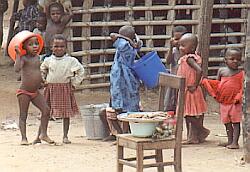 We landed in Kisangani on 4th May after three days
and nights on the river and were pretty relieved to be back on dry land. Kisangani seemed
very dilapidated, however, we did manage to find a good restaurant to have a nice thick
steak. With the incredible weak Zaire currency running at about 500,000 to the US Dollar
the meal set us back several million Zaires! Zaire was another extremely poor country
crippled by corruption, the ordinary people seemed to have nothing. After another couple
of days drive we arrived at the Epulu Nature Station. A guide took us on a short tour and
pointed out some of the unique Okapi, which look like a cross between a Giraffe and a
zebra!
We landed in Kisangani on 4th May after three days
and nights on the river and were pretty relieved to be back on dry land. Kisangani seemed
very dilapidated, however, we did manage to find a good restaurant to have a nice thick
steak. With the incredible weak Zaire currency running at about 500,000 to the US Dollar
the meal set us back several million Zaires! Zaire was another extremely poor country
crippled by corruption, the ordinary people seemed to have nothing. After another couple
of days drive we arrived at the Epulu Nature Station. A guide took us on a short tour and
pointed out some of the unique Okapi, which look like a cross between a Giraffe and a
zebra!
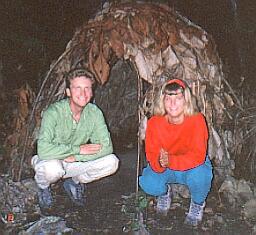 From Epulu we took a tour out to one of the forest
pygmy villages and spent the night with them. The village was deep in the rain forest and
despite the hot sun the forest canopy kept the whole place pleasantly cool. The tiny
pygmies made us all seem like lumbering giants. In the afternoon we went out hunting with
the men and caught a small forest deer called a Dic Dic. Although interesting we felt
somewhat intrusive in their village and I didn't really feel comfortable. We also had to
spend the night sleeping in a small pygmy banana leaf hut which wasn't long enough to keep
our heads dry once the rain came. All in all I was glad to be trekking back to the truck
the next day, I didn't really fancy spending another night in that damp, cramped hut!
From Epulu we took a tour out to one of the forest
pygmy villages and spent the night with them. The village was deep in the rain forest and
despite the hot sun the forest canopy kept the whole place pleasantly cool. The tiny
pygmies made us all seem like lumbering giants. In the afternoon we went out hunting with
the men and caught a small forest deer called a Dic Dic. Although interesting we felt
somewhat intrusive in their village and I didn't really feel comfortable. We also had to
spend the night sleeping in a small pygmy banana leaf hut which wasn't long enough to keep
our heads dry once the rain came. All in all I was glad to be trekking back to the truck
the next day, I didn't really fancy spending another night in that damp, cramped hut!
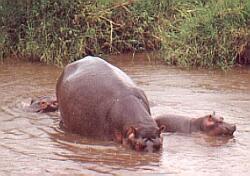 After another 3/4 days drive we arrived at Lake
Edward on the border with Uganda, here we visited the Virunga National Park. In the park
we spent some time watching a hippo wallowing in a pool with her calves. We also spotted
Lion, Colubus, Baboon, Warthog, Topi, Gazelle and a good selection of birdlife. After the
park we continued to the waterfalls of the Chutes Rutshuru, where most of us took
advantage of the river and had a good wash. For the evening we stopped in the grounds of a
lodge overlooking the Virunga Plateau so Paula and I decided to take a room for a 'Luxury
Fix'.
After another 3/4 days drive we arrived at Lake
Edward on the border with Uganda, here we visited the Virunga National Park. In the park
we spent some time watching a hippo wallowing in a pool with her calves. We also spotted
Lion, Colubus, Baboon, Warthog, Topi, Gazelle and a good selection of birdlife. After the
park we continued to the waterfalls of the Chutes Rutshuru, where most of us took
advantage of the river and had a good wash. For the evening we stopped in the grounds of a
lodge overlooking the Virunga Plateau so Paula and I decided to take a room for a 'Luxury
Fix'.
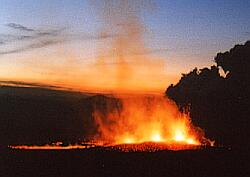 Our next adventure was a two day hike up to visit
some active volcanoes. We began the hike from Tongo which is near the point where the
Zaire, Uganda and Rwanda borders intersect. We set off each with day packs and 7
porters to carry the tents and cooking equipment. The arduous 6 hour hike took us up
through some small banana plantations, forest and finally across a recent lava flow. We
set up camp just 200m from the cone of a volcano that had erupted 2 months ago. We climbed
the cone and form the top we could see 3 small active volcanoes spewing lava into the air
just a mile or so from us - spectacular! The cone we climbed was covered in a loose
volcanic scree and still warm to the touch, in places one could see red hot embers glowing
just a few steps away. We stayed up on the rim until the sunset to see the lava lighting
up the evening sky and then returned to camp for dinner. We bedded down about 9.30pm as we
were due to leave at sunset. Suddenly at around 11.30pm we were awoken by three fairly
violent earth tremors and a roaring sound. While Pulling on our boots we clambered out of
the tents to find the sky lit up by a new volcano which was erupting only 500m from us. We
all marveled at the new volcano for an hour or so and then retried to our tents to get
some sleep. The guides seemed to think that we were not in any real danger, which was hard
to believe given our proximity to this latest volcano.
Our next adventure was a two day hike up to visit
some active volcanoes. We began the hike from Tongo which is near the point where the
Zaire, Uganda and Rwanda borders intersect. We set off each with day packs and 7
porters to carry the tents and cooking equipment. The arduous 6 hour hike took us up
through some small banana plantations, forest and finally across a recent lava flow. We
set up camp just 200m from the cone of a volcano that had erupted 2 months ago. We climbed
the cone and form the top we could see 3 small active volcanoes spewing lava into the air
just a mile or so from us - spectacular! The cone we climbed was covered in a loose
volcanic scree and still warm to the touch, in places one could see red hot embers glowing
just a few steps away. We stayed up on the rim until the sunset to see the lava lighting
up the evening sky and then returned to camp for dinner. We bedded down about 9.30pm as we
were due to leave at sunset. Suddenly at around 11.30pm we were awoken by three fairly
violent earth tremors and a roaring sound. While Pulling on our boots we clambered out of
the tents to find the sky lit up by a new volcano which was erupting only 500m from us. We
all marveled at the new volcano for an hour or so and then retried to our tents to get
some sleep. The guides seemed to think that we were not in any real danger, which was hard
to believe given our proximity to this latest volcano.
 Our next adventure was to track the Gorillas! It took
us a day or so of driving through almost impassable muddy tracks to reach the village of
Rumangabo. At 5.00am we organized our group of 5 and began the three hour trek up to the
station where we would meet our guide. It was an arduous climb but we were rewarded with
good open views of the countryside and volcanoes in the distance. The guide led us into
the dense rainforest on the Zaire/Rwanda border. The forest floor was a mattress of
rotting vegetation, and at times we were clinging to branches as we scaled steep slopes
and pushed deeper into the forest in our search for the Gorillas. After a hot, sweaty and
exhausting 2 hours we spotted our family of Gorillas. We spent over an hour just feet from
these spectacular animals and saw some of the huge male Silverbacks and a mother with baby
- quite unforgettable. It was incredible how close we were to them!
Our next adventure was to track the Gorillas! It took
us a day or so of driving through almost impassable muddy tracks to reach the village of
Rumangabo. At 5.00am we organized our group of 5 and began the three hour trek up to the
station where we would meet our guide. It was an arduous climb but we were rewarded with
good open views of the countryside and volcanoes in the distance. The guide led us into
the dense rainforest on the Zaire/Rwanda border. The forest floor was a mattress of
rotting vegetation, and at times we were clinging to branches as we scaled steep slopes
and pushed deeper into the forest in our search for the Gorillas. After a hot, sweaty and
exhausting 2 hours we spotted our family of Gorillas. We spent over an hour just feet from
these spectacular animals and saw some of the huge male Silverbacks and a mother with baby
- quite unforgettable. It was incredible how close we were to them!
The trip next took us to the town of Goma on Lake Kivu. Paula and I discovered there was a ferry leaving the next morning for a 9 hour sailing down to Bukavu at the southern end of the lake. The other guys on the trip didn't seem to interested so we arranged to meet the group in Bukavu and took the ferry the next morning. Not surprisingly our ferry, the 'Kanzimbi', was a rusty bucket of bolts, but it set sail dead on time at 7.00am! It was a beautiful trip sailing down the entire length of Lake Kivu and stopping in at small villages on the way. The villagers would paddle out in their pirogues selling their wares. Part of our cargo was a prisoner in chains, but then we seemed to be carrying just about everything!
We spent a few days in Bukavu and ended up befriending a local teacher who invited us to speak at a local private school. The teacher explained how the government hadn't paid the teachers for 5 months and thus all the state schools were closed! We met up with the truck only to find that yet another person had contracted malaria - six now! On 28th May despite the border being officially closed we crossed from Zaire into Burundi and drove to the capital Bujumbura. It was here that Paula and I decided to leave the tour and do the rest of the trip across Tanzania and into Kenya on ourselves. We spent a few days in the capital enjoying a few of the better hotels and getting ready for the next stage of our journey.
 The first exciting stage was to take the historic MV
Liemba steamer down Lake Tanganyika to Kigoma in Tanzania. The ship, built in 1914, had
been scuttled by the Germans in the Second World War and then raised from the lake floor
by the British and put back into service! We had a nice little cabin and a memorable time
sailing down Lake Tanganyika with a star studded sky. From Kigoma we caught the train for
the 1,300km, 48 hour trip, across Tanzania to Dar es Salaam on the Indian Ocean. The train
journey was another truly African experience!
The first exciting stage was to take the historic MV
Liemba steamer down Lake Tanganyika to Kigoma in Tanzania. The ship, built in 1914, had
been scuttled by the Germans in the Second World War and then raised from the lake floor
by the British and put back into service! We had a nice little cabin and a memorable time
sailing down Lake Tanganyika with a star studded sky. From Kigoma we caught the train for
the 1,300km, 48 hour trip, across Tanzania to Dar es Salaam on the Indian Ocean. The train
journey was another truly African experience!

 We arrived in Dar es Salaam on 8th June and were
rather disappointed by the run down and dirty city. After a day of rest we caught the
ferry out to the exotic island of Zanzibar. Zanzibar was a retreat for the Sultan of Oman
and became the center of trade, wealth and cultural life. Slavery and ivory made the city
one of the richest in the world. The city seemed and exotic blend of African, Indian and
Arab life. We decided to take a tour of the old 'Stone Town' and the 'Spice Tour' with a
local celebrity, Mr. Mitu. On the 5 hour tour we visited the site of the old slave market
and administrative buildings, one of the Sultans Persian Baths, and a herb and spice farm.
At the farm we saw lemon grass, mint, pepper, ginger, turmeric, cinnamon, nutmeg,
clove, cardamom, soap tree, henna tree and coffee bushes, all growing in a small area.
We arrived in Dar es Salaam on 8th June and were
rather disappointed by the run down and dirty city. After a day of rest we caught the
ferry out to the exotic island of Zanzibar. Zanzibar was a retreat for the Sultan of Oman
and became the center of trade, wealth and cultural life. Slavery and ivory made the city
one of the richest in the world. The city seemed and exotic blend of African, Indian and
Arab life. We decided to take a tour of the old 'Stone Town' and the 'Spice Tour' with a
local celebrity, Mr. Mitu. On the 5 hour tour we visited the site of the old slave market
and administrative buildings, one of the Sultans Persian Baths, and a herb and spice farm.
At the farm we saw lemon grass, mint, pepper, ginger, turmeric, cinnamon, nutmeg,
clove, cardamom, soap tree, henna tree and coffee bushes, all growing in a small area.
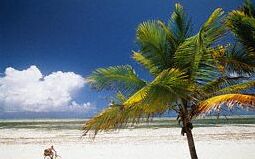 After a few days in Zanzibar town we decided to cross
the island and visit one of the tropical beaches of the east coast. We spent almost a week
at the beach of Bwejuu, staying in a basic but comfortable guest house. During the days we
occupied ourselves with sunbathing, swimming and cycling on rental bicycles. In the
evenings we would indulge in the abundant and cheap supply of great seafood. We felt that
our time lazing at Bwejuu was a well deserved rest - traveling can be exhausting!
After a few days in Zanzibar town we decided to cross
the island and visit one of the tropical beaches of the east coast. We spent almost a week
at the beach of Bwejuu, staying in a basic but comfortable guest house. During the days we
occupied ourselves with sunbathing, swimming and cycling on rental bicycles. In the
evenings we would indulge in the abundant and cheap supply of great seafood. We felt that
our time lazing at Bwejuu was a well deserved rest - traveling can be exhausting!
After our little rest in 'Paradise', we traveled back to Zanzibar town. From the main town we caught a boat across to Changuu (Prison) Island to visit the giant tortoises. We hiked around the tiny coral atoll, which took about an hour, and spotted some of the tortoises - they were huge measuring up to a meter in length and half a meter in width, and some being over 100 years old! On 18th June we flew from Zanzibar to Mombassa in Kenya. We decided that the 50 minute flight in the Foker 50 would save us a good deal of time and give us a chance to enjoy some of the Kenyan coast, including the famous island of Lamu.
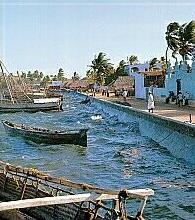 I had intended to go
diving off the coast near Watamu, but the ocean was too rough, so we headed directly Lamu.
The main town on the island of Lamu dates at least to the 14th century. Through the
centuries the island and the surrounding archipelago shifted from Portuguese to Omani and
finally to British rule before Kenya gained independence in the early 1960s. It was during
the Omani period in the 19th century that the island flourished as a trading center for
ivory, mangrove poles and, after the trade was banned further south, slaves from the
interior bound for the Middle East. The population boomed, and the island became a center
for Swahili and Arab art and learning unrivaled on the African coast. The island still
retains an exotic flavor with its narrow winding streets of white washed houses and richly
carved doors, the absence of motor vehicles, and the Arab sailing dhows on the quay-side.
Paula and I managed to find a great little room in the old town of Lamu in a traditional
house. We spent about 5 days on the island enjoying the charm of the old town. We also
managed to squeeze in a trek across the island to the village of Matandoni and a dhow trip
out to the idyllic beaches of Manda Island.
I had intended to go
diving off the coast near Watamu, but the ocean was too rough, so we headed directly Lamu.
The main town on the island of Lamu dates at least to the 14th century. Through the
centuries the island and the surrounding archipelago shifted from Portuguese to Omani and
finally to British rule before Kenya gained independence in the early 1960s. It was during
the Omani period in the 19th century that the island flourished as a trading center for
ivory, mangrove poles and, after the trade was banned further south, slaves from the
interior bound for the Middle East. The population boomed, and the island became a center
for Swahili and Arab art and learning unrivaled on the African coast. The island still
retains an exotic flavor with its narrow winding streets of white washed houses and richly
carved doors, the absence of motor vehicles, and the Arab sailing dhows on the quay-side.
Paula and I managed to find a great little room in the old town of Lamu in a traditional
house. We spent about 5 days on the island enjoying the charm of the old town. We also
managed to squeeze in a trek across the island to the village of Matandoni and a dhow trip
out to the idyllic beaches of Manda Island.
From Lamu we headed directly back to Mombassa and then caught the overnight train up to Nairobi, the Kenyan capital. We purchased 1st class tickets an were pleasantly surprised by the standard of our cabin in the ex- colonial train. Dinner was really fun with a five course silver service meal served by waiters dressed in white, if a little tatty, uniforms. After a good nights sleep we enjoyed our breakfast in the dining car with the Kenyan landscape rolling by. Just at breakfast we spotted Thompson Gazelle, Giraffes, Ostrich and Wildebeest! Nairobi was the big, bustling, noisy city that I had remembered.

 We spent a few days doing chores and then headed out
on a 5 day camping safari of Lake Nakuru National Park and the Masai Mara Game Reserve. We
visited the Lake Nakuru National Park just after sunrise and were rewarded by great views
of the crater lake and flocks of pink Flamingos. We also spotted several other animals,
including rhinoceros. In the region of Lake Nakuru we visited other crater lakes including
Lake Naivasha and Lake Elmentaita, where we saw more huge flocks of the pink Flamingos.
We spent a few days doing chores and then headed out
on a 5 day camping safari of Lake Nakuru National Park and the Masai Mara Game Reserve. We
visited the Lake Nakuru National Park just after sunrise and were rewarded by great views
of the crater lake and flocks of pink Flamingos. We also spotted several other animals,
including rhinoceros. In the region of Lake Nakuru we visited other crater lakes including
Lake Naivasha and Lake Elmentaita, where we saw more huge flocks of the pink Flamingos.

 After the lakes we visited the world famous Masai
Mara Game Reserve which is actually the Kenyan side of the Serengeti Reserve in Tanzania.
In the reserve we made several long game drives and spotted most of the big African game.
The park seemed to really embody the Africa that one sees in the television documentaries.
After the game drives we would drop into one of the luxury lodges for a 'Sundowner' and
debrief on the days game spotting.
After the lakes we visited the world famous Masai
Mara Game Reserve which is actually the Kenyan side of the Serengeti Reserve in Tanzania.
In the reserve we made several long game drives and spotted most of the big African game.
The park seemed to really embody the Africa that one sees in the television documentaries.
After the game drives we would drop into one of the luxury lodges for a 'Sundowner' and
debrief on the days game spotting.
Back in Nairobi Paula and I had only a few days together, before she flew off to India and I joined the Guerba overland tour. It was an emotional few days and when Paula flew out on 4th July I felt very alone. On 6th July I joined up with the six week Guerba overland tour from Nairobi to Harare in Zimbabwe. It felt strange to be back on another overland truck.
 Our first destination was the famous Ngorongoro
Crater National Park of Tanzania. At the rim of the crater, at an altitude of 2,300m, we
stopped for a beer and had a great view over the crater which has a diameter of 17km. The
crater has formed a sealed ecosystem and contains a high concentration of wildlife. The
next day we did a couple of extensive game drives in the crater and spotted a vast variety
of animals, including a herd of Wildebeest. After Ngorongoro we visited the Olduvai Gorge
where some of the earliest fossils of man were discovered. Next we spend several days game
driving in the world famous Serengeti Game Reserve. This park certainly wasn't a
disappointment as we saw almost every imaginable East African large mammal. Some of the
highlights were watching a Leopard preening itself in a tree and watching a Cheetah with
her two cubs.
Our first destination was the famous Ngorongoro
Crater National Park of Tanzania. At the rim of the crater, at an altitude of 2,300m, we
stopped for a beer and had a great view over the crater which has a diameter of 17km. The
crater has formed a sealed ecosystem and contains a high concentration of wildlife. The
next day we did a couple of extensive game drives in the crater and spotted a vast variety
of animals, including a herd of Wildebeest. After Ngorongoro we visited the Olduvai Gorge
where some of the earliest fossils of man were discovered. Next we spend several days game
driving in the world famous Serengeti Game Reserve. This park certainly wasn't a
disappointment as we saw almost every imaginable East African large mammal. Some of the
highlights were watching a Leopard preening itself in a tree and watching a Cheetah with
her two cubs.
Back in Arusha we set about scouting for the best deal to climb Mount Kilimanjaro. After a full day of bargaining I agreed a price of $290 for the 6 day climb - all inclusive. This turned out to be the best deal that anyone had found so I coordinated the trip for the ten of us.
 Day 1. At midday on 15th July my group of 10
assembled with the guides and porters at the gates to the Kilimanjaro Park at an altitude
of 1,980m. We took a group foto shot and then began our hike towards the summit - an
almost 4000m accent! The trail first took us through lush equatorial rainforest, with moss
draped trees. After 3 hours we reached our first station, Mandara Hut at 2,730m, where we
would spend the night.
Day 1. At midday on 15th July my group of 10
assembled with the guides and porters at the gates to the Kilimanjaro Park at an altitude
of 1,980m. We took a group foto shot and then began our hike towards the summit - an
almost 4000m accent! The trail first took us through lush equatorial rainforest, with moss
draped trees. After 3 hours we reached our first station, Mandara Hut at 2,730m, where we
would spend the night.
Day 2 we climbed slowly up through tussock grassland and giant heather moorland. After an arduous 5 hours we reached the second station, Horombo Hut at 3,780m. We spent 2 nights at this level with the hope of acclimatizing our bodies to the altitude. Unfortunately the weather had closed in so there wasn't really much to do other than rest.
Day 4. The weather had cleared by the time we set off at 08.30, so we had spectacular views of the plains below - we already seemed a long way up. We could see the Kibo peak in the distance - we still had a good climb ahead! The trail continued through the grasslands and then gave way to high altitude desert as we reached the saddle between the two major peaks. At 15.00 we reached the 3rd station, Kibo Hut at 4,710m. We could all certainly feel the altitude now and as I lay resting I took my pulse which was running at 120 beats per minute! After a little food we all tried to bed down at 18.00 as we had a very early start the next day.
 Day 5. At 00.30 we all began to drag ourselves out of
the sleeping bags ready for the 01.30 set off time. The Kibo Hut was very basic and
without light, so we all fumbled around in the cold trying to prepare to leave. We set off
by moonlight towards the Kibo Peak on schedule - it was around -20 degrees Celsius! After
an exhausting 4 hours of scrambling up loose scree we reached the Hans Meyer Cave at
5,180m. After a ten minute rest in the freezing cold it was time to set off again - the
altitude was too much for some people and 5 out of the group of 10 turned back! After the
cave the path steepened further and the loose scree sapped our energy. I could feel my
heart pounding and I was gasping for air as the sun rose and we could finally see our
goal. Another 2 hours later we reached Gilman's Point on the crater rim at 5,680m. We were
now well above the snow line and had great views across the crater to the glaciers on the
other side. From Gilman's Point it was a further 2 hours across the ice cap up to the
Uhuru peak. We were all gasping for air and my head was spinning as we set off towards
Uhuru. Two more people decided that they had had enough so now we were three. Walking
around the rim to Uhuru was spectacular with awesome views of the ice fields and plains of
Africa below. Finally at 10.00 the three of us reached the Uhuru Peak at 5,900m - the
'Roof of Africa'! From the peak it took us only 7 hours to descend right down to the
Horombo Hut. After 15 hours of hiking I had used up every once of energy in my body when I
reached Horombo, so it was a very early night for me. I had been the most physically
demanding day of my life and I felt content knowing that I had reached the summit.
Day 5. At 00.30 we all began to drag ourselves out of
the sleeping bags ready for the 01.30 set off time. The Kibo Hut was very basic and
without light, so we all fumbled around in the cold trying to prepare to leave. We set off
by moonlight towards the Kibo Peak on schedule - it was around -20 degrees Celsius! After
an exhausting 4 hours of scrambling up loose scree we reached the Hans Meyer Cave at
5,180m. After a ten minute rest in the freezing cold it was time to set off again - the
altitude was too much for some people and 5 out of the group of 10 turned back! After the
cave the path steepened further and the loose scree sapped our energy. I could feel my
heart pounding and I was gasping for air as the sun rose and we could finally see our
goal. Another 2 hours later we reached Gilman's Point on the crater rim at 5,680m. We were
now well above the snow line and had great views across the crater to the glaciers on the
other side. From Gilman's Point it was a further 2 hours across the ice cap up to the
Uhuru peak. We were all gasping for air and my head was spinning as we set off towards
Uhuru. Two more people decided that they had had enough so now we were three. Walking
around the rim to Uhuru was spectacular with awesome views of the ice fields and plains of
Africa below. Finally at 10.00 the three of us reached the Uhuru Peak at 5,900m - the
'Roof of Africa'! From the peak it took us only 7 hours to descend right down to the
Horombo Hut. After 15 hours of hiking I had used up every once of energy in my body when I
reached Horombo, so it was a very early night for me. I had been the most physically
demanding day of my life and I felt content knowing that I had reached the summit.
Day 6. Today it was a 25km hike down to the park gates, which we managed in about 6 hours. From the gates we took a taxi to Moshi, where we caught the overnight train to Dar es Salaam.
After Tanzania we crossed into Malawi which is one of the smallest and poorest countries in Africa. Malawi has several strict rules for example men must not have long hair and women cannot wear trousers - this meant many of the girls on the truck had to change for their entry into Malawi! The people seemed very hospitable and it was easy to see why the country was called 'The warm heart of Southern Africa'.
 Malawi is dominated by the huge, fresh water, Lake
Malawi running the length of the country. We camped for several days on the eastern shore
of the lake at Chintheche. One morning, as the sun climbed out of the lake, I was lucky
enough to see a Fish Eagle fish for breakfast - it was quite an idyllic setting. We spent
the few days at Chintheche swimming, enjoying the sandy beach and generally relaxing. In
the evenings there was also a well stocked bar to add to the holiday resort feel of the
campsite!
Malawi is dominated by the huge, fresh water, Lake
Malawi running the length of the country. We camped for several days on the eastern shore
of the lake at Chintheche. One morning, as the sun climbed out of the lake, I was lucky
enough to see a Fish Eagle fish for breakfast - it was quite an idyllic setting. We spent
the few days at Chintheche swimming, enjoying the sandy beach and generally relaxing. In
the evenings there was also a well stocked bar to add to the holiday resort feel of the
campsite!
Further south on the lake we stopped in at Salima Bay which again had a pleasant beach. I had great fun in a local market bartering away many of my clothes for beautiful wood carvings - I was only just decent when I finally left the market! On 31st July we left Malawi and entered Zambia. We apparently needed to make up a little time so we spent a couple of days driving through the country with a brief stop in the capital, Lusaka.
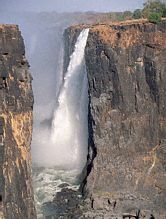 On the evening of 2nd August we crossed the bridge
over the Victoria Falls Gorge from Zambia to Zimbabwe. The next morning a group of us
hired bicycles and cycled down to the Victoria Falls National Park. We spent a couple of
hours admiring the awesome falls where the mighty Zambezi River plunges over 100m down
into the gorge. The falls sent up a huge column of spray and it was easy to understand why
the falls are known locally as 'The smoke that thunders'. After the falls we went for a
very civilized tea at the famous old colonial Victoria Falls Hotel. In the evening we all
went out on a 'Sundowner cruise' on the Zambezi. On the cruise we spotted several hippos
and crocks as we downed a few beers and watched the sun sink into the river.
On the evening of 2nd August we crossed the bridge
over the Victoria Falls Gorge from Zambia to Zimbabwe. The next morning a group of us
hired bicycles and cycled down to the Victoria Falls National Park. We spent a couple of
hours admiring the awesome falls where the mighty Zambezi River plunges over 100m down
into the gorge. The falls sent up a huge column of spray and it was easy to understand why
the falls are known locally as 'The smoke that thunders'. After the falls we went for a
very civilized tea at the famous old colonial Victoria Falls Hotel. In the evening we all
went out on a 'Sundowner cruise' on the Zambezi. On the cruise we spotted several hippos
and crocks as we downed a few beers and watched the sun sink into the river.
 The next couple of days we spent whitewater rafting
on the raging Zambezi. The first day we were given a short safety talk before the 700 feet
scale down to the river. We all apprehensively climbed aboard the rafts which were in a
calmer wide bend of the river. Our guide gave a further crash course in the raft and then
we were drifting towards the first rapid. We had 26 km ahead of us with 16 sets of rapids,
most of which were Grade 5 - the toughest possible for commercial rafting! We went round a
bend and there we could see the first huge rapid coming up on us. We all braced ourselves
as our raft was sucked into the raging class 5 water - breathtaking. The water crashed
over the raft and we all held on for our lives. Before the lunch stop we successfully
navigated rapids 4 to 10 which included rapids named 'Stairway to Heaven' and the
'Muncher'. After lunch it was rapids 11 to 16 including the infamous rapid called
'Oblivion'. The huge 3rd wave of the Oblivion rapid sucked our raft under and we were all
catapulted into the bubbling turmoil - what a rush! With the help of the safety lines we
all eventually managed to climb back aboard. I enjoyed the whole thing so much that I did
it all again the next day - a true glutton for punishment!
The next couple of days we spent whitewater rafting
on the raging Zambezi. The first day we were given a short safety talk before the 700 feet
scale down to the river. We all apprehensively climbed aboard the rafts which were in a
calmer wide bend of the river. Our guide gave a further crash course in the raft and then
we were drifting towards the first rapid. We had 26 km ahead of us with 16 sets of rapids,
most of which were Grade 5 - the toughest possible for commercial rafting! We went round a
bend and there we could see the first huge rapid coming up on us. We all braced ourselves
as our raft was sucked into the raging class 5 water - breathtaking. The water crashed
over the raft and we all held on for our lives. Before the lunch stop we successfully
navigated rapids 4 to 10 which included rapids named 'Stairway to Heaven' and the
'Muncher'. After lunch it was rapids 11 to 16 including the infamous rapid called
'Oblivion'. The huge 3rd wave of the Oblivion rapid sucked our raft under and we were all
catapulted into the bubbling turmoil - what a rush! With the help of the safety lines we
all eventually managed to climb back aboard. I enjoyed the whole thing so much that I did
it all again the next day - a true glutton for punishment!

 After the Victoria Falls it was off to Botswana and
the word renowned Okavango Delta. The delta is on the northern edge of the Kalahari Desert
and is formed by the River Okavango flowing down from the Angolan heights into a basin
that has no exit. The crystal clear waters nourish this arid area creating a wonderland of
meandering waterways, green islands and lush vegetation. The ecosystem is filled with a
diversity of flora and fauna including hippo, crocodile, elephant and even the big cats.
We began our journey into the delta by taking a 1.5 hour speedboat journey from Maun and
then we transferred into dugouts. Our guide punted our dugout along the narrow channels
through the reeds and pointed out the wildlife. As evening approached we set up camp on
one of the many islands and sat around a camp fire discussing the animals we had spotted
during the day. Back at Maun a few of us took a trip in a 6-seater light aircraft over the
delta - this really gave us a good perspective of the beautiful delta.
After the Victoria Falls it was off to Botswana and
the word renowned Okavango Delta. The delta is on the northern edge of the Kalahari Desert
and is formed by the River Okavango flowing down from the Angolan heights into a basin
that has no exit. The crystal clear waters nourish this arid area creating a wonderland of
meandering waterways, green islands and lush vegetation. The ecosystem is filled with a
diversity of flora and fauna including hippo, crocodile, elephant and even the big cats.
We began our journey into the delta by taking a 1.5 hour speedboat journey from Maun and
then we transferred into dugouts. Our guide punted our dugout along the narrow channels
through the reeds and pointed out the wildlife. As evening approached we set up camp on
one of the many islands and sat around a camp fire discussing the animals we had spotted
during the day. Back at Maun a few of us took a trip in a 6-seater light aircraft over the
delta - this really gave us a good perspective of the beautiful delta.
 From Maun in Botswana we traveled back through
Francistown and to the border with Zimbabwe. We crossed into Zimbabwe and then drove up to
Bulawayo where we spent a pleasant afternoon, before bush camping for the last time of the
trip. Next we visited the impressive ruins of Great Zimbabwe, the ancient city of the
Karanga people. The ruins are some 500 years old and are the most comprehensive south of
the Sahara. We spent a few hours exploring the various enclosures and then had a few beers
at the Great Zimbabwe Hotel.
From Maun in Botswana we traveled back through
Francistown and to the border with Zimbabwe. We crossed into Zimbabwe and then drove up to
Bulawayo where we spent a pleasant afternoon, before bush camping for the last time of the
trip. Next we visited the impressive ruins of Great Zimbabwe, the ancient city of the
Karanga people. The ruins are some 500 years old and are the most comprehensive south of
the Sahara. We spent a few hours exploring the various enclosures and then had a few beers
at the Great Zimbabwe Hotel.
 Next we traveled up to Harare, the capital of
Zimbabwe. Harare seemed a fairly modern bustling capital with all of the normal amenities.
We all took advantage of being back in a big city hitting the shops and restaurants. I
went out for a farewell meal with several of the guys from the trip and on the evening of
18th August I caught be direct flight to London. It seemed amazing how the flight whisked
me back to London in 9.5 hours after we had spent 7 months traveling overland down to
Harare!
Next we traveled up to Harare, the capital of
Zimbabwe. Harare seemed a fairly modern bustling capital with all of the normal amenities.
We all took advantage of being back in a big city hitting the shops and restaurants. I
went out for a farewell meal with several of the guys from the trip and on the evening of
18th August I caught be direct flight to London. It seemed amazing how the flight whisked
me back to London in 9.5 hours after we had spent 7 months traveling overland down to
Harare!